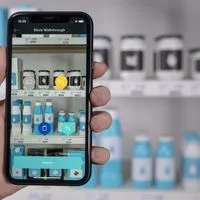The AR-t of the Possible
| Retail
:format(jpeg))
Augmented reality (AR). Kudos to whoever named the technology as it is very descriptive. Enhancing your real-world experience by layering digital elements on top of physical ones.
It can take many forms and is being used widely in retail.
More associated with e-commerce, the applications of AR are extensive. A digital way of ‘trying before you buy’ that is helping retailers with their bottom lines.
Interacting with products that have an AR experience leads to a 94% higher conversion rate.
Source: Snap Inc and Deloitte
But in physical stores, and grocery stores in particular, the possibilities can go further than you think.
By scanning barcodes with Scandit-powered smart devices, retailers can provide shoppers with a wealth of information by adding augmented reality to their retail apps.
In-store personalization
Make the experience feel personalized to shoppers’ preferences and there is a good chance they will reward you with their loyalty.
of consumers are more likely to make repeat purchases from companies that personalize.
Source: McKinsey & Company
Leveraging first party data from a loyalty app such as profile and purchase history, grocers can get an understanding of who shoppers are and what they like.
Combine that data with Scandit MatrixScan Augmented Reality, and shoppers can scan the product shelf with their smartphone and receive personalized offers. Displaying them as a screen overlay via a loyalty app.
:format(jpeg))
Grocers can be as specific as they like with their offers. Or they can gamify the experience to bring an element of excitement to the weekly shop.
How about offering freebies strategically placed around the store? A sure-fire way to create a bit of a buzz, get shoppers using the loyalty app and more importantly giving them value and a reason to return.
Product exploration
Like online, shoppers want information and advice about the products they’re going to buy in store.
Exploring products by reviewing information can go in several directions.
Two examples of the type of information that shoppers are asking for and that AR can provide, are nutrition and allergens.
Food intolerances are on the rise and shoppers are making healthier choices now more than ever.
Powering customer apps with smart data capture, shoppers can receive instant insight into which products are best for them. Helping with informed choices. A hybrid store experience, just by holding their phone up to a shelf.
:format(jpeg))
Want to go deeper? Shoppers could select their fitness goals in the app and indicate that they are training for a certain event that requires higher protein foods. If the data exists, it can be displayed.
Sustainability is also an important factor. Shoppers might be after locally produced items.
Using AR overlays on shoppers’ devices, grocers can highlight which food items have the lowest ecological impact. Or even display the logo of a local well-known farm against produce that shoppers have expressed an interest in.
In all cases it’s important to remember that you are helping shoppers to make informed decisions and improving their in-store experience.
AR isn’t just visual
Augmented reality experiences don’t have to be only visual. Sound and touch can offer further feedback to shoppers to help improve their experience.
These are also easy to build into the user experience when shoppers are using smartphones. After all, they will already be in their hand for most of the shopping trip.
Grocers can get creative and provide assisting sounds. Like a ‘kerching!’ for a particular bargain the shopper has found when scanning a shelf. Or a simple ‘ding’ for when something has been added to their basket.
:format(jpeg))
Haptic feedback can cover the element of touch.
A digital ‘touch on the shoulder’ serving as a timely reminder to buy complimentary staple products. You’ve scanned cookies, did you remember to get milk?
Or a small vibration when scanning for low sodium products on a crowded shelf.
Smartphones are about as good as it gets when it comes to one device impacting multiple senses.
Work with shoppers
With lots of possibilities on the table to improve customer experience and help shoppers make informed decisions, working with them will be key.
Get creative with ideas but make sure to be providing them with the information they need. When they need it and where they want to see it, hear it, or feel it.
Getting the balance right with what you provide and what they value is important. So listening to customer feedback is a crucial part of any new features you might include in your customer app.

Scandit augmented reality
Digitally enriched in-store experiences